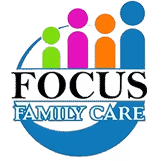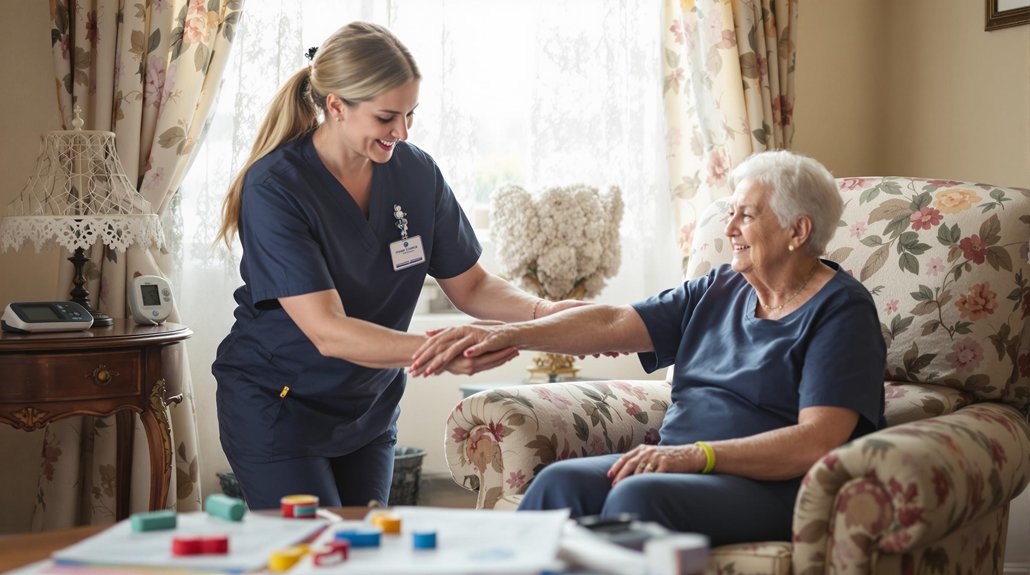Home recovery lets you heal and rehabilitate in your own living space rather than staying at a hospital or medical facility. You’ll work with healthcare professionals who coordinate your care plan while enjoying the comfort of familiar surroundings. The process includes setting up a safe environment, using medical equipment, following treatment schedules, and receiving support from family caregivers. Understanding the key components will help guarantee your successful recovery journey.
Understanding the Basics of Home Recovery
While recovering at home after an illness or surgery can feel overwhelming, knowing the fundamentals will help you heal safely and comfortably. The home recovery basics focus on creating a supportive environment that promotes healing and prevents complications.
You’ll need to understand medication schedules, wound care protocols, and any movement restrictions your healthcare provider has specified. The recovery process requires you to monitor your symptoms, maintain proper nutrition, and follow prescribed exercise or physical therapy routines.
You’ll also need to prepare your living space by removing hazards, setting up a dedicated recovery area, and gathering essential supplies. It’s important to have emergency contact numbers readily available and coordinate with family members or caregivers who’ll assist you during this time.
Recovery care services provide personalized assistance with daily activities, medication management, and specialized support to ensure optimal healing outcomes.
Understanding these fundamentals helps guarantee a smoother shift to health.
Benefits of Recovering at Home
After establishing a solid foundation for home recovery, you’ll find numerous advantages to healing in your own space. The familiar environment of your home creates an ideal setting for both physical and mental healing, especially when you’re surrounded by loved ones who can provide emotional support throughout your recovery journey.
- You’ll experience greater comfort and reduced stress by sleeping in your own bed, using your personal bathroom, and maintaining your daily routines.
- You’ll save considerably through cost savings on hospital stays and facility fees while receiving professional care at home.
- You’ll have the flexibility to adjust your recovery schedule and activities based on how you’re feeling.
- You’ll benefit from unlimited visiting hours with family and friends, strengthening your support network and boosting your motivation to recover.
Skilled nursing care is available to monitor your recovery progress and provide expert wound care, ensuring proper healing and reducing the risk of complications.
Key Components of Home Recovery Care
Since successful home recovery depends on several essential elements working together, understanding the key components of your care plan is essential.
You’ll need to coordinate medical monitoring, physical therapy sessions, and medication management to guarantee proper healing. Establish clear recovery routines that include scheduled rest periods, exercise, and therapeutic activities.
Home modifications play a significant role in creating a safe environment. You may need to rearrange furniture, install support bars, or adjust bed height to prevent accidents and support mobility.
Your care team should include healthcare providers, family members, and caregivers who’ll assist with daily tasks. They’ll help monitor your progress, provide emotional support, and make sure you’re following medical instructions.
Remember to maintain open communication with your support network and adjust your care plan as your recovery progresses.
Clinical assessments by licensed nurses help identify potential health issues early and ensure optimal recovery outcomes.
Medical Equipment and Support Devices
Proper medical equipment and support devices form the foundation of a successful home recovery.
You’ll need to make certain that your loved one has access to essential medical supplies and therapeutic equipment that support their healing journey. Having the right mobility aids can greatly impact their independence and comfort during recovery.
- Transform the recovery space with necessary home modifications like bathroom grab bars, wheelchair ramps, and adjusted bed heights to create a safe, nurturing environment.
- Stock up on medical supplies including bandages, medications, and monitoring devices to maintain proper care protocols.
- Select appropriate mobility aids such as walkers, canes, or wheelchairs to support safe movement and prevent falls.
- Incorporate therapeutic equipment like exercise bands, specialized cushions, or cold/heat therapy devices to enhance the healing process.
Medicaid home care services can provide professional medical equipment and assistance to eligible individuals recovering at home.
Role of Healthcare Professionals in Home Recovery
Healthcare professionals play an important role in guiding your loved one’s recovery journey at home. They’ll coordinate different healthcare roles to guarantee thorough care and monitor progress throughout the recovery process.
You’ll work closely with doctors who oversee the treatment plan, nurses who provide hands-on care and training, and therapists who help with rehabilitation exercises. These experts offer essential professional support by teaching you proper caregiving techniques, monitoring critical signs, and adjusting medications as needed.
Your healthcare team will also include specialists like occupational therapists, who can help modify your home environment, and social workers, who connect you with community resources.
Occupational therapists and social workers provide vital support, from home modifications to connecting families with essential community services.
They’ll communicate regularly with you, answering questions and addressing concerns to make sure your loved one receives the best care during their recovery at home.
Focus Family Care provides comprehensive private duty nursing services to ensure continuous professional care throughout the recovery process.
Creating an Optimal Recovery Environment
Creating a comfortable and safe recovery space requires careful attention to several key factors.
You’ll want to make certain your home environment promotes healing and minimizes the risk of setbacks.
By focusing on essential elements that support recovery, you can help your loved one regain their health more effectively.
- Set up ideal lighting with adjustable options, allowing for bright light during active hours and softer illumination for rest periods.
- Choose comfortable furnishings that provide proper support while being easy to get in and out of.
- Remove obstacles and reorganize spaces to prevent accidents and make certain smooth mobility.
- Create a peaceful atmosphere by managing noise levels and maintaining a clean, clutter-free environment.
These thoughtful adjustments will help make the recovery journey more manageable and successful for your loved one.
Planning Your Home Recovery Journey
When beginning your home recovery journey, it’s essential to develop a well-structured plan that accounts for both short-term needs and long-term goals.
Start by setting realistic personal goals that align with your medical provider’s recommendations and your own capabilities.
Set achievable goals in line with your doctor’s guidance while being honest about what you can realistically accomplish.
Break down your recovery timeline into manageable phases, focusing on specific milestones you’ll need to achieve.
You’ll want to identify which daily activities you can handle independently and where you’ll need assistance.
Consider creating a schedule that includes medication times, therapy sessions, and rest periods.
Regularly assess your progress and adjust your plan as needed.
Remember that serving others starts with taking care of yourself first.
Keep track of your achievements, no matter how small, and maintain open communication with your healthcare team throughout your recovery journey.
Safety Measures and Risk Management
To guarantee a safe recovery environment, you’ll need to implement specific precautions throughout your home.
Conducting a thorough risk assessment helps identify potential hazards and establish essential safety protocols that protect both you and your loved ones during the recovery process.
- Remove tripping hazards like loose rugs and electrical cords, ensuring clear pathways between frequently used rooms – your safety depends on unobstructed movement.
- Install proper lighting and nightlights to prevent falls during nighttime bathroom visits – darkness can be your biggest enemy.
- Keep emergency contact numbers visible and easily accessible – quick response times save lives.
- Place frequently used items within arm’s reach and reorganize furniture to accommodate mobility aids – your independence matters.
These measures create a secure environment that supports your healing journey while maintaining dignity and comfort.
Family Support and Caregiving Strategies
The journey to recovery becomes more manageable with strong family support and well-coordinated caregiving. You’ll need to balance emotional support with practical assistance while addressing caregiving challenges that arise during home recovery.
| Support Type | Strategy |
|---|---|
| Physical | Take turns assisting with daily tasks to prevent caregiver burnout |
| Emotional | Listen actively and provide encouragement during difficult moments |
| Medical | Track medications and appointments while monitoring recovery progress |
Remember to maintain open communication with your loved one and other family members involved in the caregiving process. You can create a schedule to share responsibilities, ensuring everyone understands their role. When you’re feeling overwhelmed, don’t hesitate to seek help from support groups or professional caregivers who can provide respite care and valuable guidance.
Technology and Home Recovery Solutions
Modern technology offers powerful tools to enhance your home recovery experience and streamline daily care routines.
With telehealth innovations and smart home devices becoming increasingly accessible, you’ll find numerous ways to support your recovery journey while maintaining independence and peace of mind.
- Connect with healthcare providers through secure video consultations, ensuring you receive timely medical guidance without leaving your home.
- Monitor essential signs and medication schedules using smartphone apps that alert both you and your caregivers.
- Install voice-activated smart home devices to control lighting, temperature, and security systems when mobility is limited.
- Use wearable technology to track your recovery progress, sleep patterns, and physical activity levels, helping you stay motivated and informed about your healing journey.
Conclusion
Recovery at home means being patient with yourself while your body heals. Think of it as a step-by-step process, like climbing stairs – you take one step at a time until you reach the top. Some days will be easier than others, and that’s perfectly normal. Remember, you don’t have to handle everything by yourself. Just like a garden needs time and care to bloom, your recovery needs support and patience to succeed.
We understand this journey can feel overwhelming, but you’re never alone. Focus Family Care‘s team is here to walk beside you every step of the way, providing the support and care you need to recover safely and comfortably in your own home.
If you or a loved one need help, don’t wait. Reach out to Focus Family Care today at (561) 693-1311 or email us at info@focusfamilycare.com.




